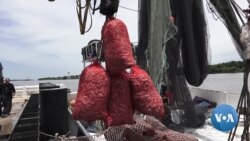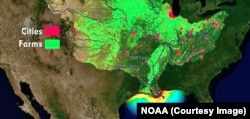Tuan Tran has been catching shrimp in the Gulf of Mexico ever since he was a child and cannot imagine doing anything else.
“I always had a passion for shrimping. I always loved the Gulf," Tran told VOA. "Some reason when I do this, I feel like I belong there."
For Tran, it is an adventure. For his family, it is a trade they had known in Vietnam before they made their way to Port Arthur, Texas after the fall of Saigon in 1975. Tran and his family of shrimpers have faced many challenges created by mother nature. The latest weather-related problem in the Gulf is a giant dead zone predicted to grow to a near record in coming weeks.
“It's not good,” said Tran.
The dead zone is an area of ocean containing little to no oxygen. It is a phenomenon that typically peaks in the summer and dissipates in the winter. However, this summer's dead zone in the Gulf of Mexico is predicted to be unusually large -- threatening marine life and creating problems for the fishermen who depend on the ocean for their livelihood.
Even with such a bleak forecast, Tran, who is a devout Catholic, relies on his faith to stay hopeful.
“We can only do so much and ask for his blessing. He'll take care the rest," Tran said. "If I get worried just like Trey over [at] J.B.S, I won't have no sleep."
Trey Pearson runs J.B.S. Packing, Inc., a shrimp processing business in Port Arthur. He said he was "very very concerned as to what it [the dead zone] will actually do and how bad it really will be."
The National Oceanic and Atmospheric Administration predicts the dead zone in the Gulf of Mexico will span more than 20,277 square kilometers, not far from the record set in 2017.
Dead zones can be found in oceans around the globe. Scientists cite an alarming trend that the number of dead zones in the world tends to double every 10 years.
Researchers say one of the main causes of a dead zone is fertilizers from farms creating nutrient pollution runoff into oceans.
In the U.S., severe spring flooding in the Midwest sent runoff from farms south, down the Mississippi River and into the Gulf of Mexico.
“That water comes out and it stimulates an algae to grow," explained Steve DiMarco, oceanography professor at Texas A&M University's Geochemical and Environmental Research Group. "Sunlight comes in (and) algae will get that sunlight. It will start growing producing a lot of biomass, and then the algae does what algae will do. It lives and it dies and then it sinks and it sinks to the bottom."
The microbes that consume the dead algae breathe in oxygen. Once that oxygen in the salt water is depleted, the layer of fresh water on top does not allow oxygen from the atmosphere to come through to the salt water because fresh water and salt water do not mix. The depleted oxygen in the salt water at the bottom creates a dead zone that affects the marine life in the area including shrimp.
"That means a lot more shrimp are going to die and a lot more shrimp are going to move away from (the dead zone). So it’s going to change the fishing quite drastically. It has the potential to do that." Pearson added that "it makes it a lot more difficult to transit the product and it changes the areas that the boats would normally fish in.”
That would cause a financial strain for those who depend on shrimp to survive financially. However, the impact of the dead zone is uncertain because a storm or hurricane in the Gulf will stir up the water and change oxygen levels.
A team of researchers from Texas A&M University will place equipment and instruments in the Gulf to collect data such as temperature, salinity, oxygen concentration and amount of biomass in the water to get a clearer picture of the problem.
For now, Pearson and Tran can only wait to see just how bad the dead zone will be when it is expected to peak in the middle of summer. Tran says God will provide.
"He seems to always carry us through hard times. We've been doing this for the last 40 years. All the hiccups we've been having, and we're still standing here today. So, I don’t worry," said Tran.







